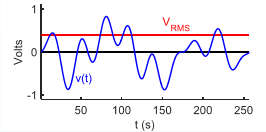This post is dedicated to RF Power theory. In today's busy world Power is consumed by various smart devices such as PC's and smartphones. Whether you connect your Phone to a cellular tower or your PC to your Wi-Fi router, the Power plays a huge role in designing Radio Frequency or Microwave AC circuits.
Power in RF Design:
- Avoid loss
- Maximum Power transfer
Instantaneos Power:
- p(t) = v(t).i(t) OR v(t)² / R
- Imagine having a simple closed circuit with voltage source and a resistor connected. Then the instantaneous power is the power at a specific time. For example, v(t=100) = 2 v, and R = 50 ohm. Then, p(t=100) = v(100)² / R = 2² / 50 = 4 / 50 W.
Average Power:
- Pavg = 1 / T ∫0T. . p(t) dt = (1 / R) . (1 / T) ∫0Tv(t)²
- Usually, we deal with periodic waveforms. Hence, T is used as a time period of the periodic waveform.
- The average v(t)² over time = < V(t)² > = (1 / T) ∫0Tv(t)²
- Vrms = √< V(t)² > = root mean square or RMS voltage.
- Thus, the average power dissipated in the resistor R is P = < V(t)² > / R or V²rms / R.
- Example Problem: RMS value? of V(t) = 2cos(wt) [voltage source], and average power dissipated in 50 ohm resistance?
- Pavg = 1 / T ∫0T. . p(t) dt = (1 / R) . (1 / T) ∫0Tv(t)²
since, V(t) = A cos (wt) => < V(t)² > = (1 / T) ∫0Tv(t)²
- (1 / T) ∫0T A2 cos2(wt) =(since avg. of cos from 0 to T = 0 [zero] )
- => < V2 (t) > = A2 / 2
- Pavg = 1/R . A2 / 2 = 1 / 50 . 4 / 2 = 2 / 50
- Vrms = √< V(t)² > = A / √2 = 2 / √2
Power and Phasor:
- 2sin(wt) = 2cos(wt - 90)
- Same Phase
- e-j90 = sin (wt) = cos (wt -90) = I, current
- Z = R; I = V / Z = | V | e-j90 / R ej0
- Z = jLw; I =V / Z = | V | ej0 / ( Lw )ej90 = (| V | / Lw)e-j90
- Pure imaginary phase difference of 90
- 90 deg phase difference between I and V
- Z = jLw = ( Lw )ej90
Power
- p(t) = v(t) i(t) = |V| |I| cos (wt + θv) cos (wt + θ1) = ( |V| |I| ) / 2 . {cos (2wt + θv + θ1) + cos(θv - θ1)}, where yellow highlighted part of the equation is = 0 mathematically.
- Average power: Pavg = ( |V | | I | )/2 . cos (θv - θ1), where ϕ = θv - θ1
- Pavg = ( |V | | I | )/2 . cos ϕ
- Vrms = | V | / √2; Irms = | I | / √2
- Thus, Pavg = Vrms Irms cos(θv - θ1)
- Example, Pavg = ( |V | | I | )/2 . cos (θv - θ1) = 0, since (θv - θ1) = 90deg.
*Advanced concepts on power to be covered in another post.





Comments
Post a Comment